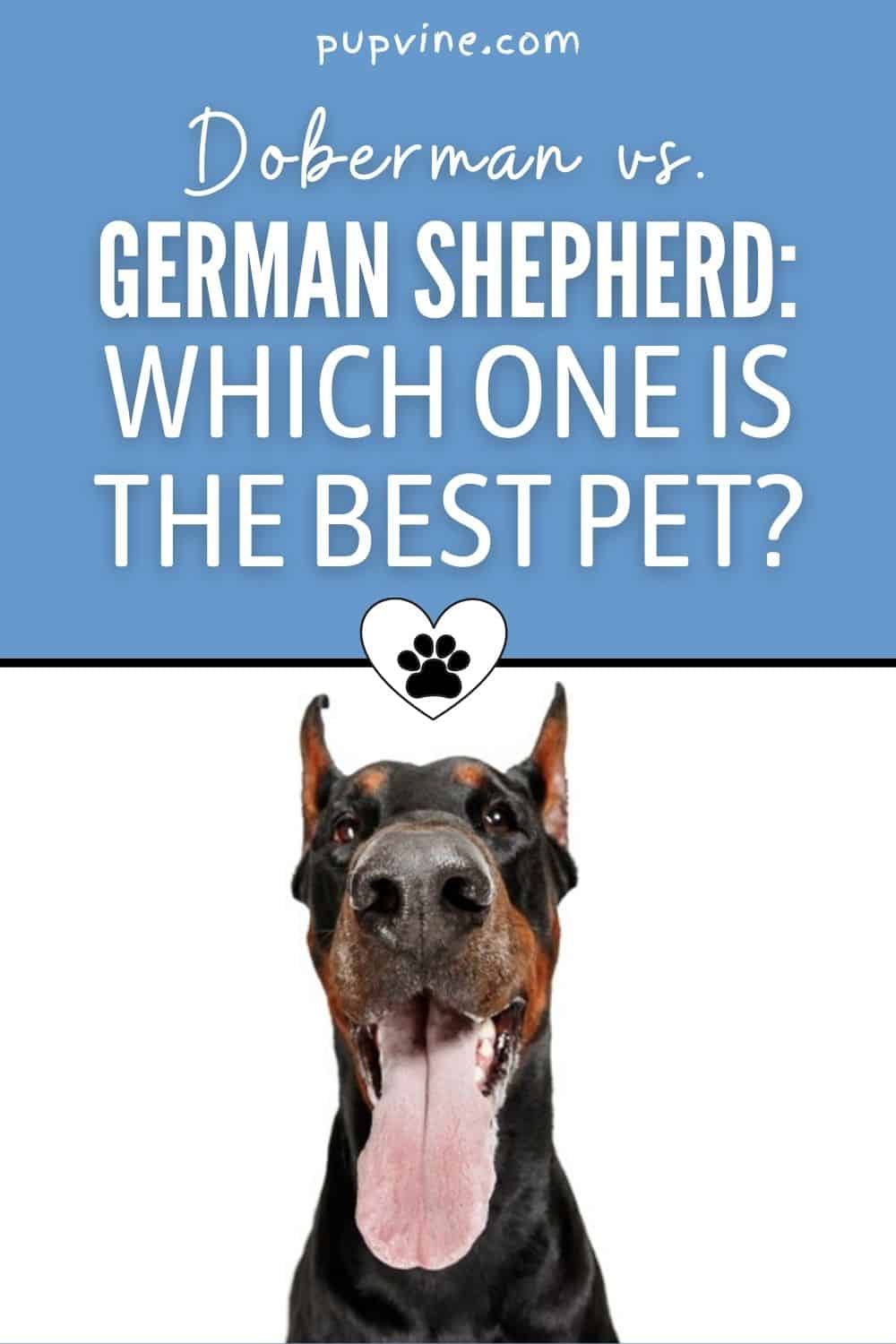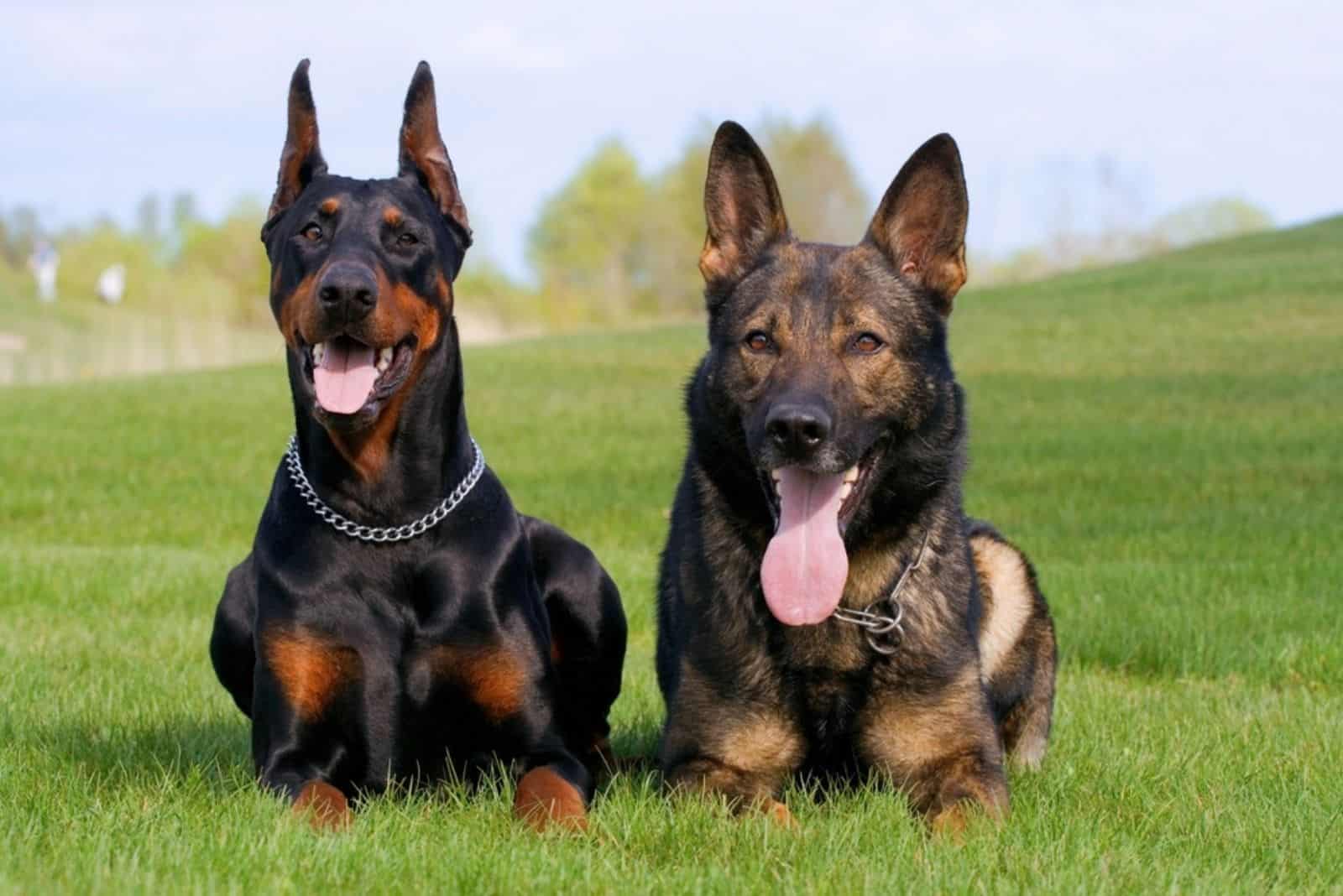Choosing the right dog for you and your home can be difficult. We all have different circumstances, lifestyles, likes and dislikes, and a whole load of factors to consider, including the breed of dog we would prefer.
Perhaps you’re considering a large dog, such as the Doberman Pinscher or the German Shepherd, and you want to find out a bit more about each breed before making that decision.
The fact is, they are both superb-looking animals, each with some amazing qualities. But that’s not very helpful to you in making your choice, is it?
What you need is a breakdown of each of these popular dog breeds that provides all the details needed to guide you in selecting the best one for you.
So that’s exactly what we’ll do!
The Doberman
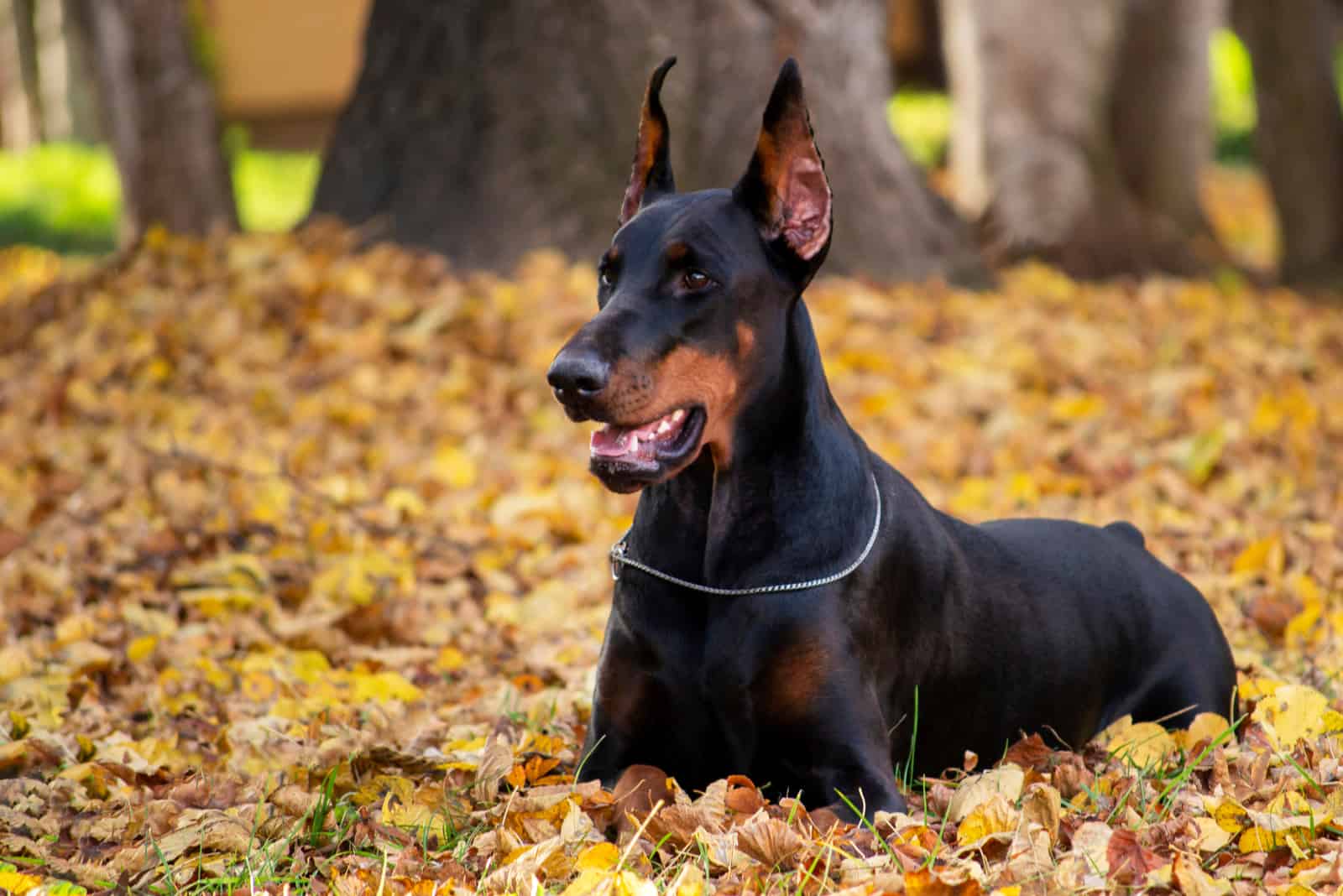
It’s fair to say that this breed has something of a reputation, going right back to its origins back in late 1800s Germany.
Karl Friedrich Louis Dobermann was a tax collector, and, as you can imagine, he felt that he needed some kind of protection while out gathering taxes.
As he owned a local dog pound, with access to many breeds, including strays, he started experimenting with breeding to produce a fierce, loyal, protective guardian.
Rumors suggest he used the Great Dane, German Pinscher, Manchester Terrier, Rottweiler, and even a bit of the German Shepherd dog, amongst others, finally producing the fearless and obedient Doberman Pinscher we have come to recognize.
This reputation has helped them remain popular as guard dogs throughout the world, where their protectiveness displays itself in fierce aggression.
They are large dogs, weighing between 29–40kg (63–88lbs), and standing between 60–72cm (24–28 inches) in height. You can look at the Doberman growth chart if you’d like to learn more about their size.
So far, they don’t sound much like a suitable family pet! But there’s far more to these complex and fascinating creatures than just keeping unwanted visitors away from junkyards and construction sites.
What About Their Temperament?
Although primarily bred as guardians, Dobermans (sometimes written as Dobermann) are naturally people-oriented. They are loyal, almost to a fault, and often bond with a single person.
Some people may worry about mixing kids with this breed, but this shouldn’t be a problem; these dogs are very protective of the whole family and usually interact well with children, especially when raised with them as they regard them as part of ‘the pack.’
One key piece of advice to note is that they rarely tolerate teasing. They may also react defensively if startled or handled badly. When it comes to children and dogs, training and education apply equally to both.
Dobermans (or Dobies, as they are also known) do not respond well to sharp words or loud voices, and they are extremely sensitive to a stressful atmosphere.
It is important to stress here that these are general traits and that each dog has its own personality.
Much of the temperament will have been inherited from the parents, and while it’s easy to see the physical traits (coat, color, eyes, and so on), it is far more difficult to determine their character until they begin to mature.
This is why early obedience training and socialization are absolutely essential in molding the pup’s character to avoid behavioral problems later on.
They respond well to positive reinforcement, which basically means they’ll learn quickly if you bribe them with treats!
Some will be natural cat-chasers, while others may be happy to be around other, smaller pets. Most will, at some point, find their ‘watchdog’ genes taking over and will be protective of you, your family, and your property.
Do They Need A Lot Of Exercise?
If you pick a Doberman as your pet, you’d better have plenty of spare time and energy! They require at least a couple of hours of exercise every day.
This is ideal if you are a runner, as they will happily keep up with you while providing you with a sense of protection!
These powerful, intelligent, and energetic dogs need to expend their energy as they can easily become bored and frustrated, which shows itself in destructive or aggressive behavior.
Even when they’ve had a long run or play in the park, they sometimes need to be kept occupied.
This can be overcome by hiding a treat or a toy somewhere in the home and commanding them to find it.
Don’t make this too difficult, though! They need to have a sense of achievement, a reward at the end of the search.
How Much Care Do They Need?
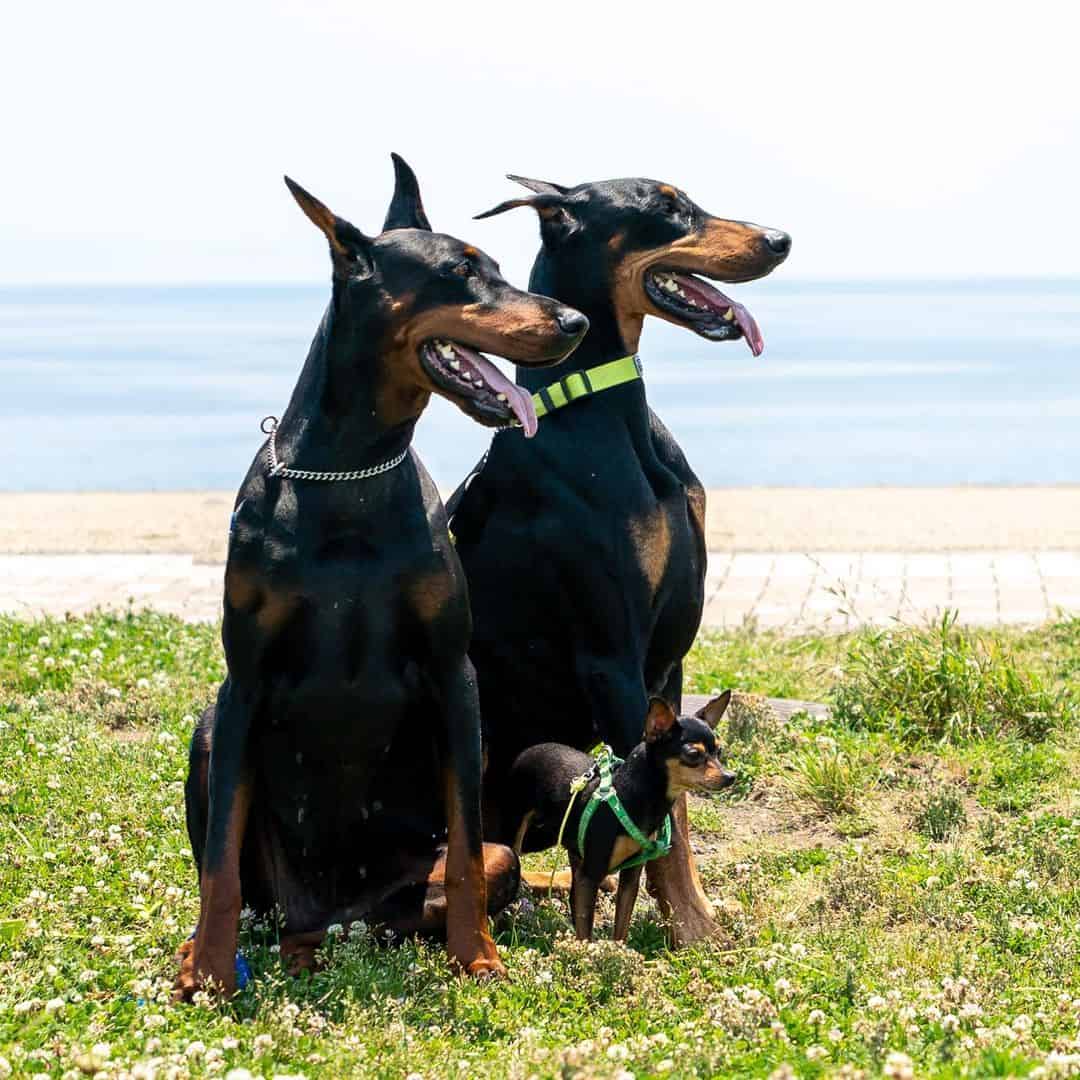
Photo from:@bee_bee_meisa
The Doberman’s coat is very short and flat and doesn’t need a lot of grooming. They have a ‘single coat,’ which means they don’t have a second ‘undercoat’ like some other breeds such as the Labrador Retriever.
It isn’t that they don’t shed at all, but rather that they don’t shed excessively at certain times of the year.
A good five-minute brush once a week (perhaps outside!) will suffice, ideally using a grooming mitt to remove all the loose hairs.
This will distribute the natural oils throughout the coat and keep it sleek and healthy.
Their coats are usually black with tan detail, though you can find fawn, blue, and red coats (again with tan markings).
Regular bathing is a must for any dog. However, too much bathing can be bad for them as it can dry out their skin.
The Dobies’ short coat needs bathing about once every six to eight weeks — unless they give you a good reason to wash them sooner.
Use a breed-specific (or at least a good quality brand) dog shampoo to keep that beautiful coat in the very best of health.
Do They Eat A Lot?
Diet can be difficult for this breed. They need masses of protein because of their size, but it should be high-quality and easy to digest.
Check the ingredients list to see what comes first, as this will be the main ingredient. A meat protein such as beef, chicken, or lamb is a good sign.
This should then be followed by a whole grain such as brown rice or a healthy source of fiber such as sweet potato.
Avoid any dog foods with cheap fillers like wheat, corn, or animal by-products as the main ingredient as these will not be good for your dog.
What they need, aside from protein, is fatty acids, fats, carbs, vitamins, and minerals.
Human foods such as basil, jasmine rice, scallops, and jicama can help you supplement your dog’s diet with the necessary nutrients.
The actual amount will depend on their size and level of activity. For more detailed advice, you can check with your veterinarian or follow the guidelines given by the dog food manufacturer.
Do They Have Any Health Problems?
As with most purebred dogs, there are common health issues to be aware of, such as:
• Von Willebrand’s disease — A blood disorder that stops blood from clotting properly. Any flesh wounds will bleed much more than usual as a result.
• Hip dysplasia — The hip joint is malformed, meaning that the ball and socket don’t fit perfectly. This usually leads to arthritis in later life.
• Eye defects — There are a few to choose from: cherry eye, cataracts, entropion, and so on. All of them can be overcome with the right treatment. However, progressive retinal atrophy can lead to blindness.
• Dilated cardiomyopathy — Basically, this is an overgrown heart, which doesn’t function correctly as a result.
• Bloat — Otherwise known as gastric dilatation-volvulus, is a potentially life-threatening condition where the stomach twists, usually after an overly large meal or drink. It progresses rapidly as gas is produced and has nowhere to escape. This places pressure on the internal organs and restricts blood flow to the heart. It can also cause a tear in the stomach lining.
• Wobbler syndrome — The common (and easier!) name for cervical spondylomyelopathy, a condition that affects large breeds of dog, where the cervical spine (base of the neck) is compressed, causing back pain and neurological symptoms, usually related to a wobbling gait in the walk (hence the name!). This condition can cause many problems, including partial paralysis.
• Hypothyroidism — This causes weight problems, skin problems, and lethargy.
Remember, these are conditions that they might encounter. It’s a good idea to be aware of them so that you know what to look out for.
A Dobie’s average lifespan is around 10 to 13 years, and with the right care and attention, they’ll have a full and happy life.
How Much Will It Cost?
Any figures will be approximate and will fluctuate depending on circumstances.
A Doberman pup will cost between $1,500 and $2,500 from a reputable breeder, with the lower amount more likely for a pet-quality dog.
Related: 4 Best Doberman Breeders In New Jersey
With food, insurance, vet bills, toys, treats, and so on, you should consider setting aside about $3,000 a year. Even then, you should have a ‘contingency’ set aside just in case!
Now let’s take a look at the competition.
The German Shepherd
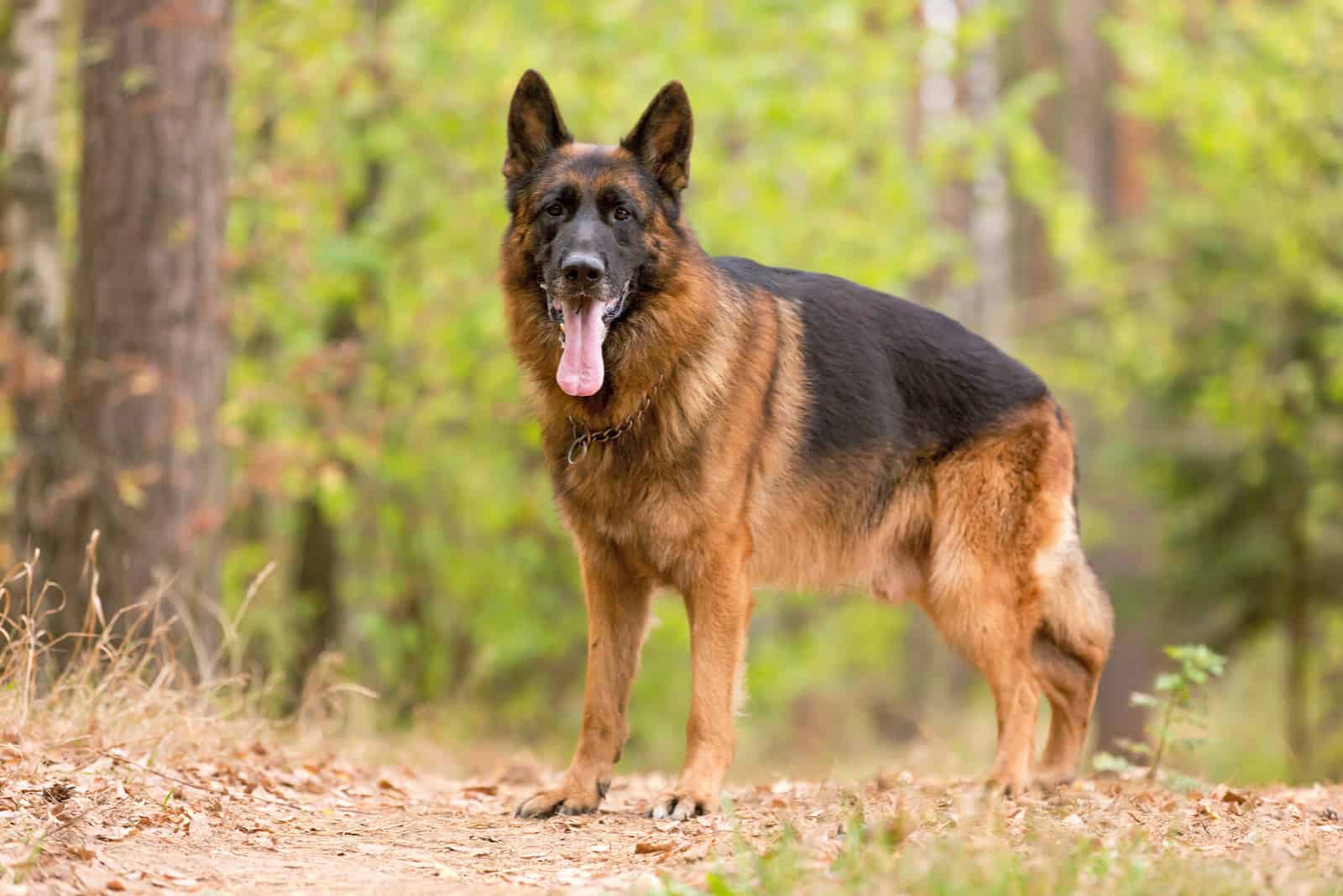
Also known as the Alsatian, this breed consistently features in lists of the most popular dogs in the world, usually in the top three.
Their alternative name was reputedly introduced in the UK after WWl to avoid anti-German sentiments having a negative impact on the breed.
As a breed, it is of a similar age to the Doberman, though it was bred for different reasons — the name might be a bit of a giveaway.
Max von Stephanitz, a German dog breeder, first produced this breed as a working dog to perform the task of herding.
They needed to be highly-trainable, very intelligent, strong and fearless, and with a keen sense of smell. At the time, predators could be a problem in the remote farmlands and countryside.
The Alsatian’s physical resemblance to its distant ancestor, the gray wolf, along with its strength, made it perfect for keeping livestock safe.
Realizing its excellent qualities, the German army soon recruited thousands of them to deliver supplies during WWI. Just prior to this, in 1912, the American Kennel Club recognized the German Shepherd as a breed.
Following the war, their fame spread worldwide, and they rapidly became a highly-prized working dog in police services everywhere.
You may have witnessed a police dog display where a fake criminal making a hasty getaway is brought down by the powerful jaws of an expertly-trained German Shepherd.
Those jaws are indeed powerful, with a bite force of around 238 psi! (Though it is only right to add here that the Doberman’s bite force is reported to be about 305 psi)
They also make excellent ‘seeing-eye’ dogs for the sight-impaired, ‘sniffer dogs for law enforcement agencies or search and rescue teams.
Standing at around 25 inches at the withers for males and 23 inches for females, they are not small dogs. As for their weight, both sexes can be as much as between 75–95lbs.
But do they make good pets?
Are They Good-Natured?
Both the UK Kennel Club and American Kennel Club list this German dog breed as a herding dog, and despite its value as a service dog, it has earned its place as a loyal and loving pet in countless households worldwide.
Generally speaking, they will get along with kids or other pets in your home, but once again, early socialization is essential. If raised with children, they will form a close bond and be protective towards them.
They can be very wary of strangers, which is a sign of their natural ‘watchdog’ qualities shining through.
Most German Shepherds are smart and will be eager to learn, making the task much easier. There is a risk in poorly-bred dogs to be ‘highly strung’ or very nervous.
When combined with a lack of training and socialization, the result is an aggressive dog that tends to be over-protective.
On the whole, though, they make great companions, will be loyal, adaptable, and relaxed.
Any wariness of strangers soon wears off once they realize that you are okay with them. Most of these beautiful dogs will be gentle and calm around family most of the time.
Do They Need Much Exercise?
Generally about the same as the Doberman! Some experts state that forty minutes is sufficient, but you’ll probably find that they become irritable and misbehave as they are bored and have a lot of pent-up energy.
As with most breeds, they’ll take it out on your furniture or take up barking as a means of showing their displeasure.
If you love long hikes and exploring the countryside, then this might be the right breed for you.
They are in their element outdoors and will happily trot beside you for miles. Shorter walks are okay, but these should be complemented with some high-energy games and/or training, which they absolutely love.
What About Their Care Routine?
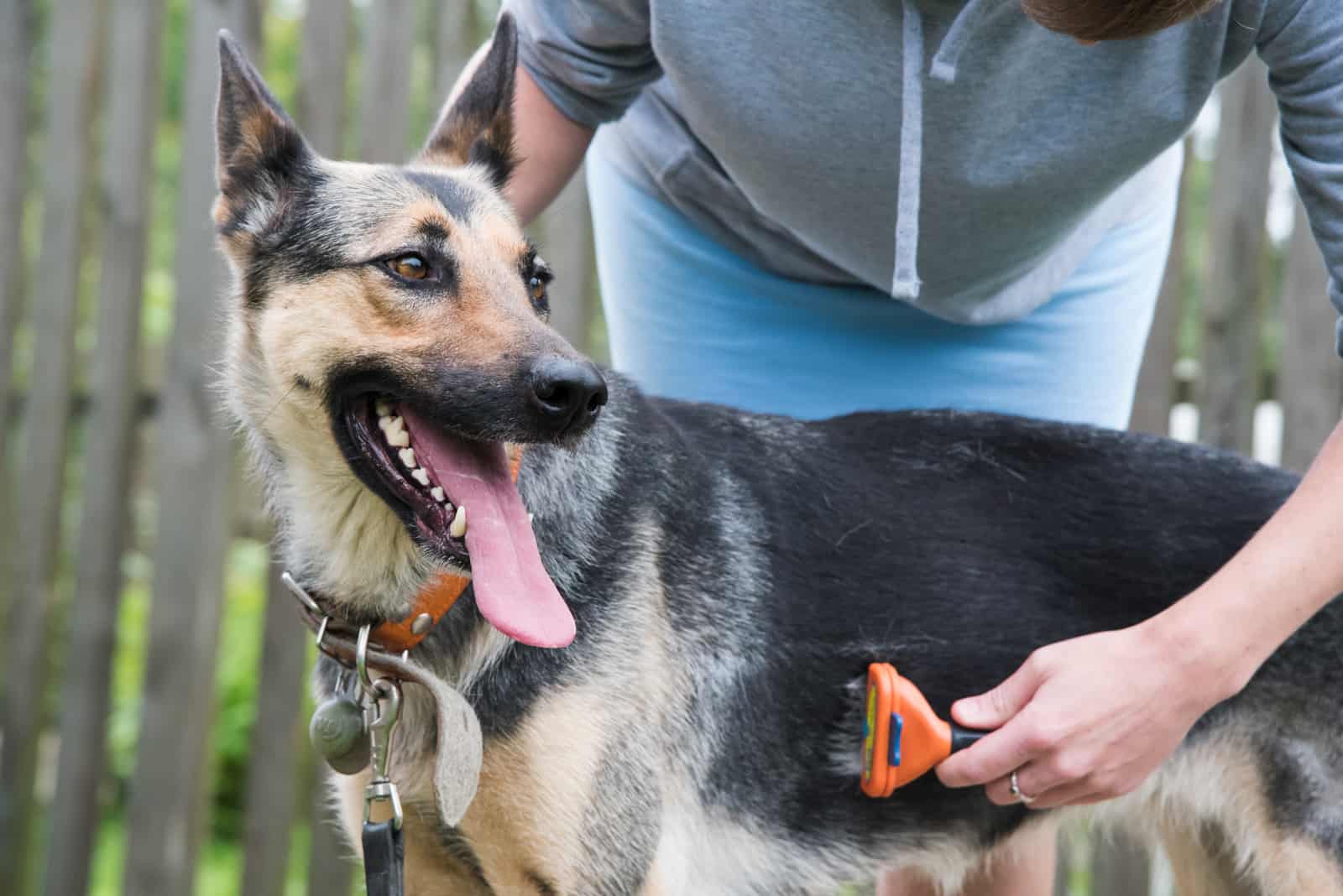
The German Shepherd dog is instantly recognizable, with its sturdy, sloping frame and sharp, upright ears.
Though we often imagine them to have the distinctive black and tan colored coat, they also come in gray, black and silver, sable, black, blue, and even red and black!
This coat is going to be thick, whatever the color. German Shepherds have a ‘double coat’ that will shed hair a lot! This might be bad news for allergy suffers.
Twice a year, in spring and fall, this double coat will start to drop, but you’ll notice hair about the place throughout the year.
You will need to brush them at least twice a week to get the loose, dead hair out and every day during the two shedding seasons. Without this, the coat will become matted, which can cause skin problems.
They won’t need bathing often, only about once every three or four months (with the obvious exception of any ‘mishaps’ where they find something nasty to roll in!).
This is because their double coat protects them — the top coat providing a shield against dirt, dust, and sunlight, while the undercoat protects against cold in the winter and heat in the summer.
Too much washing will strip away the natural oils that make the coat effective, running the risk of irritating the skin.
When you do bathe your dog, be sure to use a good quality, branded shampoo and always rinse them off thoroughly.
Any residue will dry into a powdery substance that will cause irritation and possibly lead to infection.
Be prepared for a shower yourself, as they will shake vigorously to get rid of the excess water. Then you’ll need at least two towels to get that coat dry.
Or perhaps a blow dryer (special ‘doggie dryers’ are available!), though you must be careful that it isn’t too hot or you’ll burn their skin. Also, remember to blow in the direction of the hair growth to avoid matting.
They rarely need clipping or trimming unless they have really long hair, but once in a while, they can stand a trim if the hair is getting out of hand in the hotter months.
If this all sounds too much hassle, then there are plenty of professional groomers willing to help you out.
How Much Do I Feed Them?
Again, you need to go for quality rather than quantity, but they’ll eat a fair amount because of their size.
Being active dogs with a lot of energy, they need plenty of protein, but don’t skip the other essentials such as vitamins, minerals, fatty acids, carbohydrates, and so on.
The amount you feed them (ideally in two or four sittings each day) will depend a lot on their size, age, and how active they are.
Check with your vet or see the dog food manufacturer’s guidelines for more specific help.
Are They Prone To Any Illnesses?
Sadly, yes, just like most purebred dogs. Some you may recognize from the Dobie’s list!
• Von Willebrand’s disease — As noted above, this is a blood disorder that stops blood from clotting.
• Degenerative myelopathy — This condition gradually causes paralysis, and while not painful, it has no known cure at present. In most cases, dogs with DM will live for between six months to three years.
• Epilepsy — Usually inherited, this generally shows itself between six months and three years of age.
• Skin diseases — Dermatitis, scabies, skin infections, flea-bite reactions, dry skin, and others, usually related to this breed’s susceptibility to immunological disorders.
• Hip dysplasia — Also mentioned above, this only affects a small number of German Shepherds but will need managing if discovered.
• Elbow dysplasia — Similar to the hip problem, but often more painful and complicated because of the three bones affected.
• Anal furunculosis — A particularly nasty problem that causes painful ulcers around the anus.
• Eye diseases — The most dangerous is the genetic disorder called pannus, which is not painful but which can lead to blindness if not treated.
There are others, but these few illustrate that healthcare for your dog can be a major concern. You should be ready and prepared in case any of these present themselves.
The life expectancy of a German Shepherd dog is between 10–12 years. Providing you keep them well-fed, with enough exercise, and with regular trips to the vet, then they’ll be your faithful companion for many years!
What About The Cost?
German Shepherd pups will set you back about $800, though you could expect to pay as little as $450 or as much as $1,900, depending on the breeder.
Read More: The 6 Best German Shepherd Breeders In Maryland You Need To Check Out
The first year might cost you around $3,000 to $4,000, falling to an average of $1,700 per year.
This will include all the usual stuff like visits to the vet, toys, treats, food, new collars, bowls, and so on.
Are You Ready To Choose?
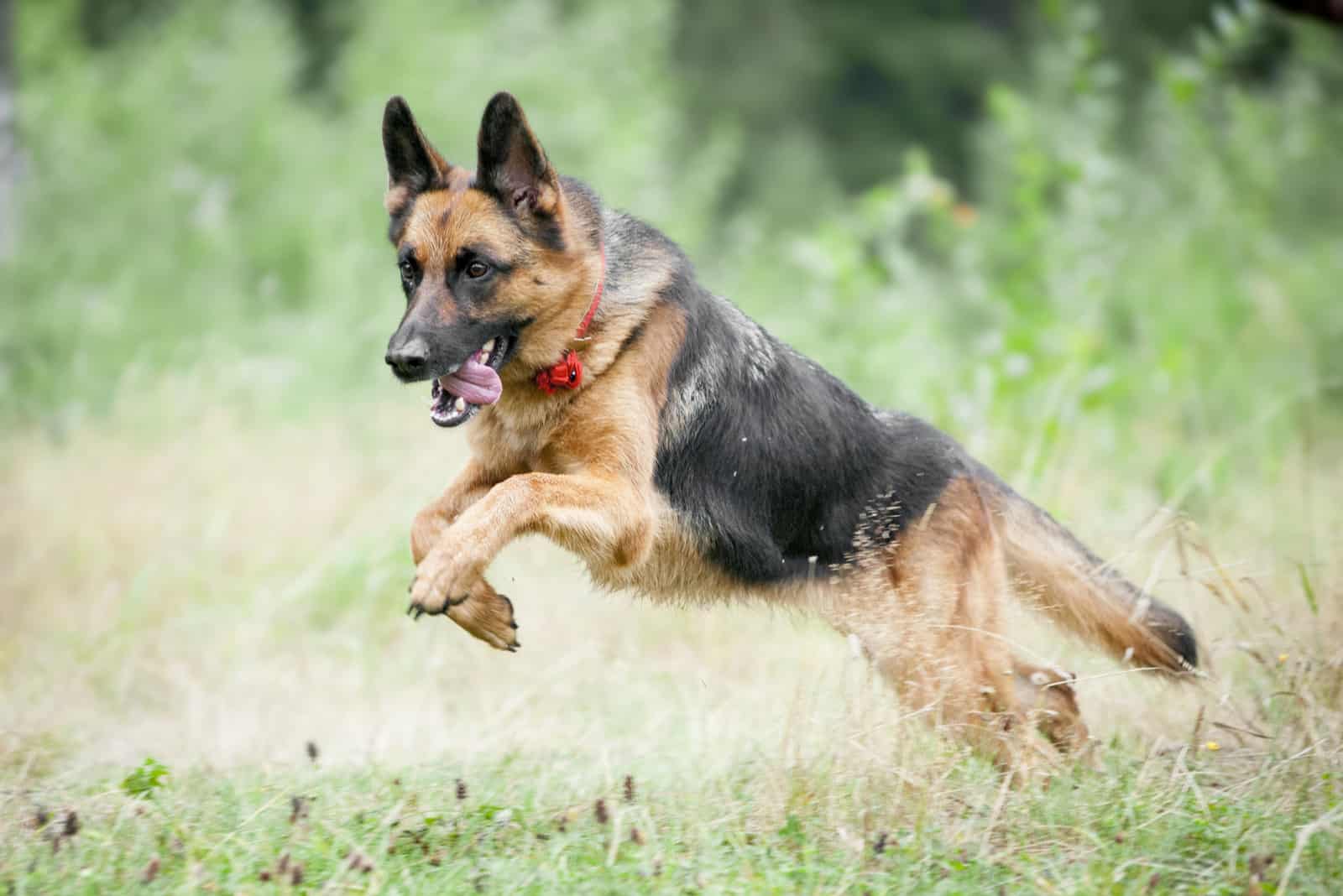
So now you know all about the two breeds, can you decide between them?
Both are pretty large dogs, energetic that need plenty of regular exercise. Both need dog training from an early age to make them obedient and keep them out of bad habits later.
Powerful dogs with energy levels to match can be a handful, which is why they aren’t always the best choice for first-time owners.
Nevertheless, both breeds make excellent family dogs given the time and the right training.
Socialization is absolutely essential for both to limit the chances of aggression and dominant behavior.
The main differences lie in the amount of grooming they require and in their temperament.
If you’re looking for a trusty companion to be your jogging or hiking buddy, who’ll protect you and who isn’t a lot of fuss when it comes to grooming, then the Dobie is your best bet.
However, the German Shepherd comes into its own as a loyal friend, always at your feet but ready to spring into action, whether to race in the park, play in the yard, or warn off the bad guys.
They’ll need a lot of grooming, but they’re worth it!
The decision is yours…
Related Articles:
